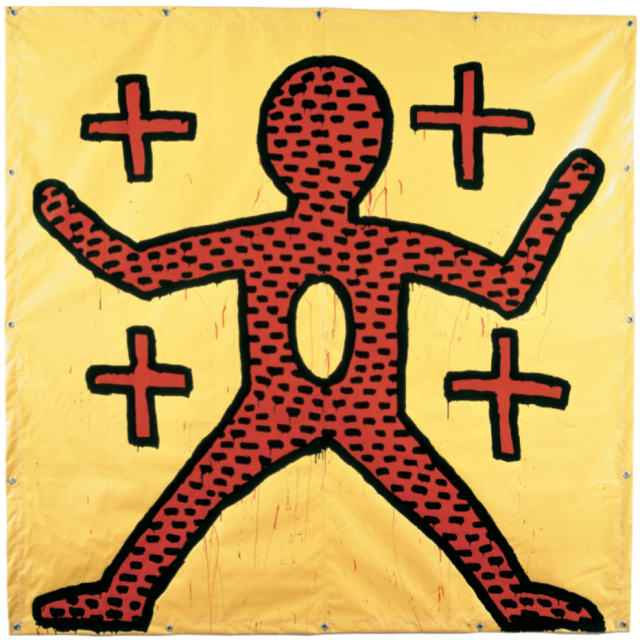Michael Wright is the creator of Still Life, a free weekly letter on art and spirit that I look forward to receiving in my inbox every Monday. On March 8 he wrote about Keith Haring (1958–1990), an artist whose work I first encountered as a child on the cover of the compilation album A Very Special Christmas, which we pulled out from the CD shelf in the family room every December. As an adult I came across Haring’s Life of Christ triptych inside Saint John the Divine in Manhattan (I instantly recognized the style), and one of his anti-apartheid paintings at the Stedelijk Museum Amsterdam. Wright discusses Haring’s connection to the Jesus People movement, which I, too, was unaware of! I share this excerpt from the latest edition of Still Life with Wright’s permission. Subscribe here.
+++

Friends,
This week I discovered that the famous street artist Keith Haring was part of the Jesus People before moving to New York City. He grew up in a Christian home in Kutztown, PA, went to church every Sunday and church camp every summer, and read the Bible voraciously. He even carefully read and rated each of the 150 Psalms. In his youth he found his way to the Jesus People movement, most likely through communes local in the area, and his early journals are filled with Christian symbols and apocalyptic ideas: “We must repent now and devote our lives to Jesus Christ! The time is now, time is running out, It can happen at any time! Be prepared for God!” Whew. I had no idea.
The Jesus People movement was a counter-cultural Christian movement of people who were anti-establishment (including church), highly critical of materialism, and committed to living with and supporting the poor. They shared their convictions through the Hollywood Free Paper, a free mailing that featured cartoons lampooning politicians, new age hucksters, and lukewarm Christians. While Haring no longer officially participated as an adult, American Art writer Natalie Phillips says there’s a “direct iconographic connection” between his style and the imagery of the paper. The Jesus People left an indelible mark on his “visual memory,” and once you know it, it’s hard to miss.
In his early subway drawings, Haring often drew the Radiant Child, a small crawling baby surrounded by beams of light. In one of the earliest versions, the baby is the central figure of a nativity scene: the Christ Child. Here’s his own description: “lines radiate from the baby indicating spiritual light glowing from within, as though the baby were a holy figure from a religious painting, only the glow is rendered in the visual vocabulary of a cartoon.” Another common image Haring used was the figure with a chest-sized hole. Sometimes filled with dollar signs, other times broken open by packs of wolves, the imagery evokes unfilled (or wrongly filled) longings and desire. And do you know what was common throughout the Hollywood Free Paper? Chest-sized holes in cartoon after cartoon, an image of spiritual voids filled by Christ himself.
On top of this, some of his late works were explicitly religious. He created a monumental series of the Ten Commandments, he created a mural for a convent in Pisa, and, most poignantly, his final work was an altarpiece of the Last Judgment, on view at both New York’s Cathedral of St John the Divine and San Francisco’s Grace Cathedral. That’s not to say “Gotcha! He’s a Christian artist!” As a gay man dying of AIDS, Haring was vocally critical of the institutional church and kept his distance during his adult life. Nor should we say this is his “religious art” and everything else is the popular stuff. His compassion for the weak and vulnerable, his critical eye to unjust systems, his celebration of the body and human dignity—this was all part of Haring’s sensibility, and it’s deeply Christ-like too, even if it’s harder to trace in work without obvious religious subject matter.
I guess I’m bringing all this up because I want you to be surprised with me. When I say “Jesus Freak,” the first thing that comes to mind is dcTalk—not a sex-positive, ambiguously spiritual, gay street artist. And yet as a teen, that’s what he called himself. Keith Haring wrote about it in his journals, and he talked openly about the influence of his Christian background. Uncovering this history doesn’t burden the artwork or the artist—it gives me renewed interest in his work. Granted, I write about these topics in Still Life all the time, but I don’t think we have to be afraid of letting religion be one of the many interpretive lenses we use to enjoy the arts. At their best, art and religion can be exactly what Haring hoped for in his own creative work: “It should be something that liberates the soul, provokes the imagination and encourages people to go further. It should celebrate humanity instead of manipulating it.”
Take care,
Michael
P.S. Many of the quotes above come from Natalie E. Phillips’ “The Radiant (Christ) Child: Keith Haring and the Jesus Movement,” published in American Art.

Thank you for sharing, really interesting. Art historians really miss something when they don’t refer to an artists spirituality.
LikeLike
[…] Still Life: For the September 13, 2021, edition of his weekly Still Life letter, Michael Wright [previously] interviewed Christian author Paul J. Pastor, having been intrigued by a recent tweet of his, which […]
LikeLike
[…] Haring was an American pop artist who died of AIDS at age thirty-one. I featured him on the blog last year, particularly his connection to the Jesus People […]
LikeLike